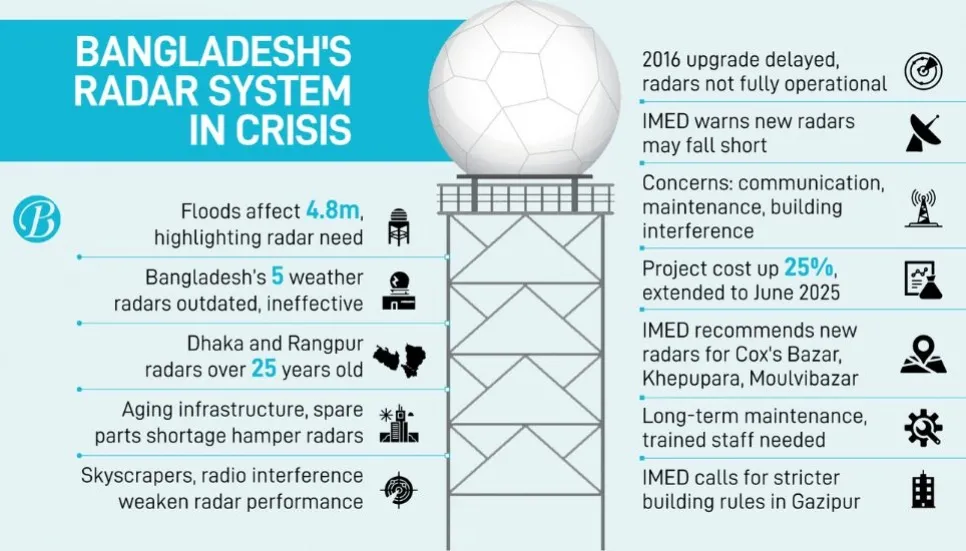
In various locations across Dhaka, Cox's Bazar, Patuakhali, Moulvibazar, and Rangpur districts, there are five weather radar stations of the Bangladesh Meteorological Department (BMD). These radars were established with technical and financial assistance from the Japan International Cooperation Agency (JICA).
As Bangladesh grapples with devastating floods that have claimed 15 lives so far and affected over 4.8 million people across 11 districts, the importance of robust weather forecasting infrastructure has never been more critical. The Ministry of Disaster Management and Relief has warned of further potential flooding towards the end of the monsoon season, with heavy downpours upstream and mountain runoff exacerbating the situation.
A persistent low-pressure system over the Bay of Bengal has triggered continuous downpours, with BMD officials pointing to the unprecedented impact on Bangladesh from simultaneous heavy rainfall in neighbouring regions such as Assam, Meghalaya, and Tripura. In this context, the condition of Bangladesh's weather radar system, which plays a pivotal role in forecasting such natural disasters, is of paramount concern.
The Dhaka and Rangpur radars, established between 1998 and 1999, are now over 25 years old and have become increasingly ineffective. The Rangpur weather radar system has reached the end of its service life, rendering it largely obsolete, while the rapid expansion of skyscrapers in Dhaka and interference from radio frequencies have significantly compromised the radar’s functionality.
Additionally, procuring spare parts for these outdated systems has become nearly impossible in the global market.
Recognising the urgent need for modernisation, the recently ousted Awami League-led government launched the “Development of Dhaka and Rangpur Weather Radars” project in 2016 to replace the outdated radars in Dhaka and Rangpur with S-band solid-state Doppler radars and integrate them into a network system with the three existing Doppler radars.
The government said that this would allow real-time visualisation of radar images at the Dhaka headquarters from all five radar stations, including the three currently in operation.
The Implementation Monitoring and Evaluation Division (IMED) under the Ministry of Planning has raised concerns in a recent in-depth project monitoring report, indicating that the project might not deliver the expected results.
IMED raises doubts about feasibility
The IMED report said that when the project was initiated in 2015, all five radar stations were old but still functional. Currently, however, none of the radars are operational. This raises doubts about the feasibility of integrating data from the three existing radars for accurate analysis.
"With the installation of the new radars, it will not be possible to establish intercommunication with the existing three radar stations in Cox's Bazar, Khepupara, and Moulvibazar, or to bring them onto the same platform. Therefore, there is a need to install new radars equipped with S-band Doppler and other modern technology at Cox's Bazar, Khepupara [Patuakhali], and Moulvibazar," the IMED report stated.
The report also criticised the project for the absence of elevators in the new high-rise radar buildings, which could pose maintenance challenges for senior meteorological officials.
Additionally, the IMED pointed out that the radar's operational and telecommunication activities might be obstructed by new high-rise buildings in the densely populated area in Gazipur. It urged the Gazipur City Corporation to enforce stricter building construction regulations.
The report further recommended that, given the unavailability of spare parts for radar equipment, long-term maintenance contracts with suppliers should be established to ensure ongoing functionality.
The project
The project was initially approved with an estimated cost of Tk 208.57 crore for the period from July 2016 to June 2019. Subsequently, the first revision extended the deadline to June 2023 and raised the cost to Tk 212.49 crore. The latest revision, approved with a budget of Tk 260.80 crore, extended the completion deadline to June 2025, marking a 25 per cent increase in project cost and a 200 per cent extension in duration.
The Bangladesh Meteorological Department (BMD), under the Ministry of Defence, is implementing the project, with funding from both the Government of Bangladesh (GoB) and Japanese grants.
Japan, one of Bangladesh's largest development partners, conducted feasibility studies through the Japan Weather Association (JWA) and International Meteorological Consultants Inc, funded by the Japan International Cooperation Agency (JICA). The Japanese Shimizu Corporation is supervising the radar installation, while the Japanese Marubeni Corporation is supplying the radar station equipment.
Although the project was set to be completed in three years, only the radar tower in Gazipur has been constructed, with its equipment installed and the station now operational. However, the construction of the radar tower in Rangpur is still ongoing, with completion expected by November 2024.
Despite the project’s commencement in July 2016, there was little progress between 2016 and 2021, primarily due to the Holy Artisan attack and the Covid-19 pandemic. The project gained momentum from the fiscal year 2021-2022, and all tenders have since been finalised.
The construction of the Joydebpur (Gazipur) radar tower, which finally began in August 2021 after a delay of one and a half years, was completed, and the radar system was handed over to the Bangladesh Meteorological Department in January 2024.
The construction of the Rangpur radar tower has also been accelerated, with completion expected by November 2024.
What did IMED recommend?
In response to these concerns, the IMED recommended that after the installation of the two new radars, initiatives should be taken to install three additional radars at the existing sites in Cox's Bazar, Khepupara, and Moulvibazar to establish interconnectivity with the current radar network.
IMED also advised that, given the lack of availability of spare parts for radar equipment, the authorities should consider entering into a long-term maintenance agreement with the supplier to ensure sustainable management. Additionally, it stressed the need to address the shortage of trained meteorologists and engineers by recruiting additional personnel and arranging necessary training.
Furthermore, the IMED urged the authorities to enforce building regulations in Gazipur, which is rapidly becoming a densely populated city, to ensure that new high-rise buildings do not interfere with radar operations and telecommunications.